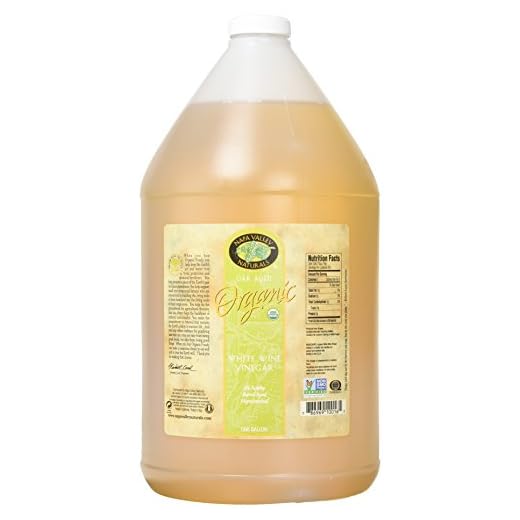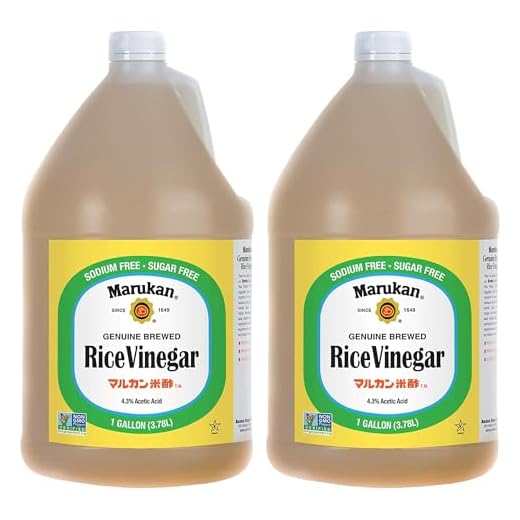



If you’re in need of a substitute for the tangy acidity that white wine vinegar provides, consider using apple cider vinegar. Its fruity notes and similar acidity make it an excellent choice for salad dressings, marinades, and even pickling. You can use it in equal proportions to achieve a comparable flavor profile.
Another solid option is champagne vinegar, which offers a lighter, more delicate taste. This variety works particularly well in dressings and sauces where you want to maintain a subtle flavor without overpowering other ingredients. Use it in the same quantities as you would the original vinegar.
Lemon juice can serve as a refreshing alternative, especially in seafood dishes and vegetable preparations. The bright acidity of fresh lemon juice provides a citrusy kick that complements a variety of cuisines. Adjust the amount based on the desired level of acidity, starting with a 1:1 ratio and tweaking as needed.
Lastly, consider using rice vinegar for a milder option. It has a slightly sweet flavor, making it suitable for stir-fries and Asian-inspired dishes. This can help balance flavors without overwhelming your palate, typically used in equal amounts to the original vinegar.
Substitutes for White Wine Vinegar
A superb alternative is apple cider vinegar. Its fruity notes and acidity mirror those of white wine vinegar, making it a reliable choice for dressings and marinades. Use it in equal amounts to achieve a similar flavor profile.
If you’re looking for something with a milder taste, rice vinegar fits the bill. It’s less acidic and has a subtle sweetness, which works well in Asian dishes. Adjust the quantity slightly, as its flavor is more delicate.
Lemon Juice as a Replacement
Lemon juice also serves as an excellent substitute due to its tartness. It adds brightness to dishes and complements salads beautifully. Use fresh juice for the best results, and start with a smaller amount, as it can be more potent than vinegar.
Champagne Vinegar Option
Champagne vinegar offers a refined alternative with its light and crisp character. Ideal for vinaigrettes and seafood dishes, it provides a gentle acidity. Substitute it in a one-to-one ratio for an elegant touch.
Understanding the Flavor Profile of White Wine Vinegar
The flavor of this acidic liquid is characterized by its crispness and slight fruitiness, making it a versatile component in various culinary applications. The subtle notes of grapes are complemented by a refreshing tang, which can enhance salads, marinades, and sauces.
Key Flavor Characteristics
- Acidity: The pronounced tartness elevates dishes, providing a bright contrast to richer ingredients.
- Fruit Notes: The underlying grape essence adds a gentle sweetness that balances acidity.
- Complexity: Depending on the production process, some varieties exhibit additional layers of flavor, such as floral or herbal hints.
Usage Tips
For optimal results, it’s advisable to use this vinegar in dressings, where its acidity can cut through fatty elements like oils and cheeses. When incorporating it into cooked dishes, add it towards the end of the cooking process to preserve its distinctive flavor.
If you’re exploring alternatives, consider the flavor profiles of substitutes carefully. Each has its unique attributes that can either complement or alter the intended taste of your dish. For instance, a splash of lemon juice or a dash of rice vinegar might offer a different yet enjoyable experience.
For practical household applications, while experimenting with flavors in cooking, you might also find yourself needing to tackle various tasks around the home. In this regard, you might wonder can you safely use soda crystals to unblock your sink as a solution.
Common Substitutes in Cooking and Their Ratios
For those occasions when you need an alternative to that specific acidity, consider the following options and their ratios:
- Cider Vinegar: Use a 1:1 ratio. This option offers a fruity note that complements many dishes.
- Champagne Vinegar: A direct swap at a 1:1 ratio. Its delicate flavor makes it suitable for dressings and sauces.
- Lemon Juice: Replace with a 1:1 ratio. This adds brightness, perfect for marinades and salads.
- Rice Vinegar: Use in equal parts (1:1). It’s milder and sweet, great for Asian-inspired dishes.
- Balsamic Vinegar: If substituting, consider using a 1:2 ratio due to its stronger flavor. Dilute with water if needed.
- Sherry Vinegar: Another 1:1 option. It provides depth and complexity to your meals.
- Tomato Juice: Use at a 1:1 ratio for a different but interesting twist, especially in sauces.
Adjustments may be necessary based on the dish and personal taste preferences. Experimentation is key to achieving the desired flavor profile.
Using Apple Cider Vinegar as an Alternative
Apple cider vinegar serves as an excellent substitute, particularly due to its tangy flavor and fruity undertones. It offers a comparable acidity that enhances dishes without overpowering them. For recipes requiring a one-to-one ratio, simply swap equal amounts of apple cider vinegar for the original ingredient.
Flavor Compatibility
The mildly sweet and tart profile of apple cider vinegar makes it suitable for dressings, marinades, and sauces. It complements salads and roasted vegetables exceptionally well, providing a refreshing twist. When using it in lighter dishes, the fruitiness can elevate the overall taste experience.
Cooking Techniques
For simmering or braising, apple cider vinegar can be incorporated seamlessly. If a recipe calls for a splash of the original ingredient for deglazing, this alternative works effectively to lift the fond from the pan. Its complex notes can add depth to reductions and glazes, making it invaluable in the kitchen.
Exploring the Benefits of Rice Vinegar
Rice vinegar offers a unique, mild flavor that can enhance a variety of dishes. Its delicate sweetness makes it an excellent choice for dressings, marinades, and dipping sauces. Unlike stronger vinegars, such as distilled or balsamic, rice vinegar contributes a subtle, nuanced taste that complements rather than overwhelms other ingredients.
Health Benefits
This vinegar is lower in acidity, which can be gentler on the stomach. It also contains beneficial amino acids and antioxidants, promoting digestive health and overall well-being. Incorporating rice vinegar into your meals may support better digestion and add a refreshing note to your culinary creations.
Culinary Uses
Incorporating rice vinegar into Asian cuisine is a natural fit, particularly in sushi rice and pickled vegetables. However, its versatility extends beyond that. Try adding it to salad dressings for a unique twist or using it to balance flavors in soups and stews. When substituting for a different type of vinegar, start with a 1:1 ratio, adjusting to taste based on the dish.
How to Use Lemon Juice as a Vinegar Substitute
Lemon juice serves as an excellent alternative due to its acidity and bright flavor. When substituting, use a 1:1 ratio, meaning one tablespoon of lemon juice can replace one tablespoon of vinegar. This will maintain the necessary acidity in your dish.
Flavor and Culinary Uses
The citrus notes of lemon juice add a refreshing zing, making it suitable for salad dressings, marinades, and sauces. For example, it enhances the flavor profile of vinaigrettes, bringing a light and zesty taste to salads. In cooking, it can balance rich dishes, especially those with fatty ingredients.
Additional Tips for Using Lemon Juice
To enhance its effectiveness, consider pairing lemon juice with a pinch of salt or adding it to a mixture containing herbs. This combination can elevate the overall taste. When using in baking, remember that the acidity in lemon juice can react with baking soda, creating a leavening effect.
| Usage | Ratio |
|---|---|
| Salad Dressing | 1:1 |
| Marinades | 1:1 |
| Baking | 1 tablespoon + 1/4 teaspoon baking soda |
Identifying When Not to Substitute White Wine Vinegar
In certain dishes, the specific characteristics of this acidic liquid are irreplaceable. For example, in delicate sauces like beurre blanc, the precise balance of acidity and flavor depth is crucial. Substituting with other vinegars can lead to an overpowering taste or a completely altered profile.
When making pickles or marinades, the unique fruity notes and mildness of this vinegar play a significant role in the final taste. Using alternatives might result in a harsher or more pungent flavor, which could overpower the intended outcome.
In recipes calling for a light touch, such as salad dressings where the acidity must complement rather than dominate, it’s best to stick with the original ingredient. The nuanced flavor of this vinegar enhances the dish without being intrusive.
For baking, particularly in recipes requiring a specific chemical reaction (like cakes or pastries), using a different type of acidity can disrupt the overall balance and affect texture. Therefore, maintaining the original ingredient ensures the desired results.
Lastly, cultural dishes often rely on traditional practices and specific ingredients. In these cases, straying from the original can compromise authenticity and flavor integrity. Staying true to the original recipe is vital for achieving the intended culinary experience.








